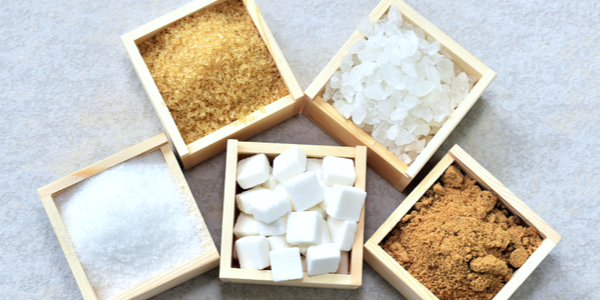
It is obvious added sugar is found in desserts, sweets, and sweetened beverages. However, added sugars can be found in many unsuspecting foods.
According to University of California San Francisco, an astounding 74 percent of packaged foods in grocery stores can have added sugar! On top of this, there are many names for sugar on labels and ingredient lists that make looking for sugar in foods confusing.
Most American adults recognize the health concerns of too much sugar in the diet. In fact, according to a survey from statista, 67 percent of Americans are trying to cut back on sugar.
While many Americans are trying to cut back on sugar, it can be tricky to catch all the different types and names of sugar on food labels. Read on for clarification of different forms of sugar, how they are used and how they can impact health.
The Health Risks of Too Much Added Sugar
While sweet treats can be enjoyed on occasion, too much added sugar in the diet can harm health. In fact, eating too much can increase the risk of countless chronic diseases, including heart disease and type 2 diabetes.
On the flip side, giving up refined sugar can change your health for the better! Despite the initial "withdrawal" symptoms, those who limit sugar intake are more apt to lose and maintain a healthy weight, think more clearly, sport healthier skin, and beyond.
To counter such risks and gain some major health benefits, the American Heart Association (AHA) suggests limiting added sugars to less than 24 grams of sugar (6 teaspoons) per day for women. Men are encouraged to consume less than 36 grams of sugar (9 teaspoons) per day.
Whether dieting or trying to eat healthier, identifying and understanding the various forms of sugar can help you make informed decisions.
Refined Sugars
Refined sugars are a general category for sweeteners that are processed, or altered from their natural form, during manufacturing. For example, white table sugar is processed from raw beets or sugar cane.
Refined sugars are most commonly found in packaged foods to add sweetness but also to extend shelf life or add texture to foods. While there are different kinds of refined sugar, they are absorbed and impact blood sugar the same way. No matter which type of refined sugar is used, the goal is to limit intake of all forms in the diet.
1. Granulated Sugar
Granulated sugar is the sugar that is recognized as the common "white" or "table" sugar. Further known as the "every day" sugar, granulated sugar is vastly used in commercial products and recipes.
Granulated sugar is almost completely sucrose, a natural sugar occurring in sugar cane, and processed down to a salt-like texture.
2. Caster Sugar
Similar to granulated sugar, caster sugar shares the same composition yet with a much finer texture.
Being small in size, caster sugar dissolves quickly, making it best for baking into dessert products.
3. Confectioners' Sugar
Also known as powdered sugar or icing sugar, confectioners' sugar is an extremely fine sugar. Among all sugars, it is the finest and smallest in size.
Confectioners' sugar is easily dissolved into toppings (such as icing, hence "icing sugar") and fillings. The finely ground sugar is typically mixed with cornstarch to prevent clumping when stored.
4. Brown Sugar
What is the difference between brown sugar and white sugar? Brown sugar is essentially white sugar with molasses, a sugar by-product that has been boiled down into a thick, dark syrup.
Though it comes in both refined and unrefined forms, both display the properties the molasses provides – a moist texture and rich taste. Brown sugar is mostly used in conjunction with granulated sugar in standard baking recipes such as chocolate chip cookies.
5. Cane Sugar
The identification of cane sugar is suggestive of its origin - sucrose extracted from sugarcane. Sugarcane is a tropical plant naturally containing a highly-concentrated, sweet substance. Though reasonably similar to granulated sugar, many desire the sweetness of cane sugar over common table sugar.
Cane sugar can be considered less processed than white sugar, but it is still altered during manufacturing. Because of this, some may assume cane sugar is healthier than other refined sugars, but that is not true. Cane sugar is metabolized the same way as other forms of sugar.
6. Corn Syrup and High Fructose Corn Syrup
Corn syrup is made from taking corn, forming it into starch, and breaking it down further by adding enzymes and other components to get the end result of a sweet, sticky liquid sweetener.
High fructose corn syrup (HFCS) is made in a similar way but has slightly more fructose as the end result.
Both liquid sweeteners are common sweeteners in many foods and beverages (like soda) because they are cheap ingredients, even though they are highly processed.
Table sugar is made up of about 50 percent fructose while HFCS is closer to 55 percent fructose. Even though HFCS has just slightly more fructose, the extra amount can negatively impact health. This is why HFCS gets a bad reputation.
Interestingly, the negative health effects associated with HFCS are not associated with fruit which is naturally a source of fructose.
Natural Sugars
There are some differences between natural sugars and refined sugars. Natural sweeteners, also known as natural sugars, come from plants or are made from animals (bees) with little to no processing. They have grown in popularity as consumers are looking for alternatives to both sugar and non-nutritive sweeteners.
Natural sweeteners are broken down in a similar way as sugar in the digestive tract, but they can contain traces of minerals, antioxidants, and even fiber. While this does merit some health benefits over refined sugars, keep in mind natural sweeteners should still be enjoyed in moderation and in line with AHA recommendations.
Examples of natural sugars include:
• Agave nectar
• Honey
• Maple syrup
• Coconut sugar
• Date sugar
• Molasses
• Raw sugar
Natural sugars can be used in baked goods or to sweeten yogurt, oatmeal, or added to drinks. One benefit of using liquid natural sweeteners, like honey or maple syrup, is you can use less amount compared to regular sugar. For example, you only need about 3/4 cup of honey for every cup of sugar when baking.
Artificial Sugars
Artificial sugars, known as non-nutritive sweeteners or low-calorie sweeteners, were created as a sugar substitute for diabetics. These sweeteners are considered to be low to calorie-free compared to regular sugar while being hundreds of times sweeter than sugar.
Consumption of non-nutritive sweeteners is controversial, though, and they can be highly processed when made. While more research is needed on long-term effects, some studies suggest non-nutritive sweeteners may increase body mass index (BMI), cardiometabolic risk, and other potentially harmful side effects.
In general, artificial sweeteners should be treated as other sugars. Using them sparingly as part of a varied diet is not likely to be cause for concern. However, if artificial sweeteners are being used in increasing amounts, consider ways to cut back.
Artificial sweeteners can include:
• Acesulfame potassium (Ace K)
• Aspartame
• Neotame
• Saccharin
• Sucralose. Sucralose is an artificial sugar that can be used to bake in place of equal amounts of sugar.
• Stevia plant-based sweeteners including stevia, truvia, and stevia in the raw. All types of stevia products are based on the naturally sweet stevia plant, but these sweeteners are made from stevia plant extracts. There are many manufacturing steps needed to get them to the sweeteners in grocery stores.
• Sugar alcohols. These are not usually used for home cooking but are found in sugar free gum, toothpaste or other sugar free sweets. An easy trick to spot sugar alcohols on packages is to look for ingredients that end in "ol".
Unusual Names for Sugar
While these different types of sugar listed above are the most common types of sugar, sugar content can hide in ingredient lists as many other science-y sounding names.
Other names of sugar that can be identified on food packages include:
• Dextrin or dextrose
• Sucrose
• Glucose syrup (or solids)
• Cane juice crystals or evaporated cane juice
• Maltose or maltodextrin
• Fructose
• Malt syrup
• Rice syrup
• Fruit juice concentrate
Conclusion: What Is the Healthiest Sugar?
When it comes down to deciphering the healthiest type of sugar, the typical consensus is this: Sugar is sugar no matter what the form.
Despite differences in flavor, appearance, and texture, one teaspoon of any type of sugar generally offers 16 calories. Some sugar sources may provide trace amounts of other nutrients, but the impact on blood sugar is the same.
No one type of sugar can be eaten without concern of excess, even artificial sugars. While artificial sugars will not raise blood sugar and have none to very low calories, some research suggests caution for their use.
For that reason, all sugars, even natural ones, should be consumed in moderation with AHA recommendations. With the average American consuming a high intake of sugar, it is important to recognize the different types of sugar and the names it can hide under.
Just because a food label does not have "sugar" in the ingredient list does not mean a food is low in sugar. Unusual names sugar can fall under dextrose, sucrose, syrups, or sugar alcohols ending in "ol".







